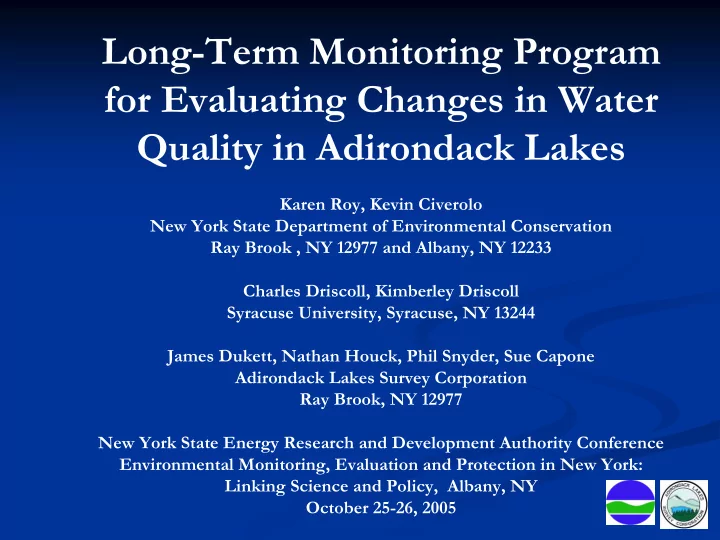

Long-Term Monitoring Program for Evaluating Changes in Water Quality in Adirondack Lakes Karen Roy, Kevin Civerolo New York State Department of Environmental Conservation Ray Brook , NY 12977 and Albany, NY 12233 Charles Driscoll, Kimberley Driscoll Syracuse University, Syracuse, NY 13244 James Dukett, Nathan Houck, Phil Snyder, Sue Capone Adirondack Lakes Survey Corporation Ray Brook, NY 12977 New York State Energy Research and Development Authority Conference Environmental Monitoring, Evaluation and Protection in New York: Linking Science and Policy, Albany, NY October 25-26, 2005
Adirondack Long Term Monitoring Program - 1982 to present * Why? To monitor changes to ecosystems arising from * Why? To monitor changes to ecosystems arising from acid rain precursors. acid rain precursors. * How? Year- -round sampling of 52 lakes on a monthly round sampling of 52 lakes on a monthly * How? Year basis and 3 streams on a weekly basis. basis and 3 streams on a weekly basis.
Approach » Monthly time series of lake chemistry » Comparisons with other regions » Comparisons between lake classes » Aluminum trends and critical levels » Weekly snowmelt chemistry » Climatic effects/hydrology
Trends of Adirondack Lakes Comparisons Over Time Periods, Lake Classes and With Other Studies
pH of wet deposition at NADP sites in the Adirondacks (Driscoll et al. 2003, 2005) NADP Site 1979-1981 1998-2000 2001-2004 Huntington Forest 4.18 4.5 4.6 Whiteface Mountain 4.1 4.5 4.6
Significant Trends in ALTM Lakes Values Are Mean Rates of Change p< 0.10 (units : µeq/L-yr, pH units, µmol/L-yr, µmol C/L-yr) Time SO 42- NO 3- C B ANC pH Al im DOC ↓ ↓ ↓ ↓ Period ↑ ↑ ↑ 1992- 44 15 26 29 18 28 7 2000 -2.57 -1.03 -3.33 1.60 0.04 -0.31 15.7 48 lakes 1992- 47 22 24 37 29 40 12 2004 -2.11 -0.50 -1.62 1.13 0.02 -0.16 9.6 48 lakes
1982 - 2004 (n=16) Min - Mean - Max (n) SO4 (16) NO3 (11) SO4 & NO3 (16) CB (16) ANC (11) H+ (10) Ali (5) -4 -3 -2 -1 0 1 2 1992 - 2004 (n=48) (n) (47) SO4 NO3 (25) (47) SO4 & NO3 (25) CB ANC (34) H+ (31) (40) Ali -6 -4 -2 0 2 4 Change in Lake Chemistry ( µ eq/L-yr)
ALTM Lake Classifications (Hydrology, Flowpath, Chemistry, Watershed Characteristics) � Thick Till/Carbonate 5 lakes � Medium Till 13 lakes � Thin Till 27 lakes � Mounded Seepage 7 lakes TOTAL 52 lakes
Acid-base Stoichiometry ∆ ANC = slope ANC 2- + NO 3 slope (SO 4 - ) ∆ C B = slope C B 2- + NO 3 slope (SO 4 - )
Thick Till - Significant change Thick Till - non Significant Change Seepage - Significant Change Seepage - non Significant Change Thin Till - Significant Change Thin Till - non Significant Change 2 1 Slope of Ca 0 (ueq/l-yr) -1 -2 -3 -4 -5 -4 -3 -2 -1 0 Slope of SO4 + NO3 (ueq/l-yr)
Stoddard et al. 2003. EPA Response of Surface Water Chemistry to the Clean Air Act Amendments of 1990
U.S. Trends (µeq/L – yr) 1990-2000 Stoddard et al. 2003 Region SO 4 2- NO 3 - C B ANC Adirondacks -2.3 -0.5 -2.3 +1.0 New England -1.8 NS -1.5 NS Appalachian -2.3 -1.4 -3.4 +0.8 Upper Midwest -3.4 NS -1.4 +1.1 Ridge/Blue Ridge 0.3 -0.1 NS NS NS – Not Significant
Critical Chemical Thresholds � pH less than 6.0 � ANC less than 50 µeq L -1 � Al im less than 2 µmol L -1 These indicate that aquatic biota are at risk from surface water acidification because of acidic deposition (Driscoll et al. BioScience Vol. 51, 2001).
Aluminum (Al im ) Trends in Lakes Lakes With Trend Mean Lakes With Decreasing (Range) Annual Value Year Trend µmols/L-yr > 2 µmols/L -0.31 2000 28 (-0.02 to -1.15) 16 -0.16 2004 40 (-0.02 to -0.89) 17
Fall ANC vs Spring ANC 300 Thin Till Medium Till 250 Thick Till Seepage 200 150 Spring ANC 100 50 0 -50 -100 -100 0 100 200 300 Fall ANC
Current status based upon sampling of Adirondack lakes over two decades: � Overall lake chemistry indicators show improvements, but not necessarily full recovery. � Improvement is non-uniform across the region. � Current measurements indicate many of the lakes continue to show critical levels of pH , ANC and toxic aluminum.
Snowmelt Chemistry
300 200 ANC min Weekly 100 0 -100 -100 0 100 200 300 ANCmin Monthly
Climatic Factors - Flow Gauging � Recent studies have shown linkages between climatic factors and the dynamics of SO 2- 4 and NO - 3 in the Adirondacks influencing response. � ALTM program is examining the feasibility of gauging flows at lake outlets.
Adirondack Long Term Monitoring Collaborators Syracuse University (C.T.Driscoll, K.Driscoll) U.S.Geological Survey(G.Lawrence, D.Burns, M. McHale) SUNY ESF (M.J. Mitchell, D.Raynal) Institute of Ecosystem Studies (G. Lovett, C. Canham, M.Pace) US EPA Corvallis (S. Paulsen, J. Stoddard) NYSERDA Environmental Monitoring, Evaluation and Protection Program DEC Air Resources; Fish,Wildlife and Marine Resources; Water Resources Others
Recommend
More recommend